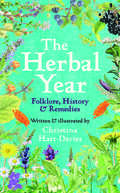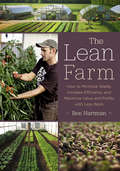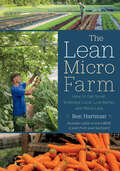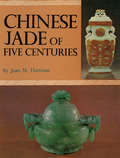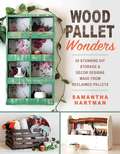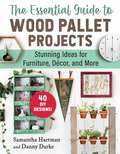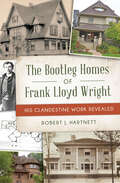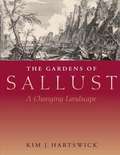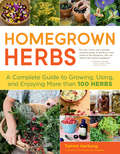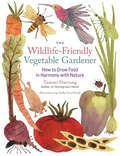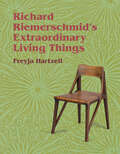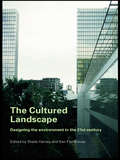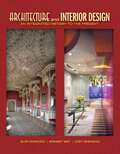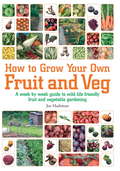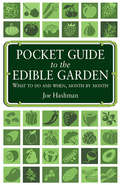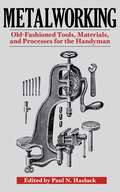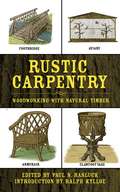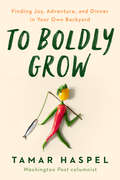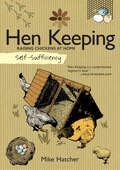- Table View
- List View
The Herbal Year: Folklore, History and Remedies
by Christina Hart-DaviesAn enchanting, beautifully illustrated guide to seasonal plants—showing the long history of herbal remedies and their uses today“[A] charming almanac. . . . Hart-Davies, a writer and botanical illustrator whose watercolors enliven her book, . . . offers a lively combination of folk history and modern science; they overlap in intriguing ways.”—Priscilla M. Jensen, Wall Street Journal From sweet violets in spring to rosemary in winter, via marigolds, sage, elderberries, and hops, every season has its own bounty of herbs and plants. Christina Hart-Davies presents a delightful guide to common plants as they appear throughout the year. Drawing on writers, storytellers, and poets from across the centuries, she examines the long history of herbal remedies. She shows how plants have been used for healing and unearths the stories and beliefs that surround them—including simple recipes for use at home. Fully illustrated with exquisitely detailed watercolours, this is an inspirational guide to exploring our age-old relationship with plants. Readers will discover the hidden secrets of the plants that surround us and, through this, will be able to reconnect with our place in nature. We have relied on plants throughout our history. We still do, and, with luck, we always will.
The Lean Farm
by Ben HartmanA practical, systems-based approach for a more sustainable farming operation To many people today, using the words "factory" and "farm" in the same sentence is nothing short of sacrilege. In many cases, though, the same sound business practices apply whether you are producing cars or carrots. Author Ben Hartman and other young farmers are increasingly finding that incorporating the best new ideas from business into their farming can drastically cut their wastes and increase their profits, making their farms more environmentally and economically sustainable. By explaining the lean system for identifying and eliminating waste and introducing efficiency in every aspect of the farm operation, The Lean Farm makes the case that small-scale farming can be an attractive career option for young people who are interested in growing food for their community. Working smarter, not harder, also prevents the kind of burnout that start-up farmers often encounter in the face of long, hard, backbreaking labor. Lean principles grew out of the Japanese automotive industry, but they are now being followed on progressive farms around the world. Using examples from his own family's one-acre community-supported farm in Indiana, Hartman clearly instructs other small farmers in how to incorporate lean practices in each step of their production chain, from starting a farm and harvesting crops to training employees and selling goods. While the intended audience for this book is small-scale farmers who are part of the growing local food movement, Hartman's prescriptions for high-value, low-cost production apply to farms and businesses of almost any size or scale that hope to harness the power of lean in their production processes.
The Lean Micro Farm: How to Get Small, Embrace Local, Live Better, and Work Less
by Ben Hartman“Ben Hartman is a true innovator for the small farm.”—Curtis Stone, author of The Urban Farmer It’s time to think big about small farms. Award-winning author and “green leader” (Grist) Ben Hartman shares practical how-to tips, personal stories, and surprising examples of cutting-edge farmers and innovators around the world to show us how. In the early 1970s, US Agriculture Secretary Earl Butz infamously commanded farmers to “get big or get out.” In The Lean Micro Farm, author Ben Hartman rejects that disastrous suggestion and instead takes up the charge of the late agrarian thinker Gene Logsdon: “Get small and stay in.” Taking inspiration from the groundbreaking ideas of E. F. Schumacher and Mahatma Gandhi, The Lean Micro Farm shows how small, hyperlocal farms can be both ecologically and economically superior to industrial-scale operations geared toward export and commodity markets. The Lean Micro Farm details the author’s remarkable journey to downsize his farm from one acre to a third of an acre in an effort to prioritize family and community over work, all without taking a pay cut. In addition, Hartman profiles six innovative farmers from across the globe who embody this “get small” mindset. These pioneering farmers show all of us a path toward resilience in the face of supply chain disruption, globalization, and climate change. They model a gentler, more ecological approach to farming that produces less waste and uses less plastic, petroleum, and fertilizer. Like his previous two books, The Lean Farm and The Lean Farm Guide to Growing Vegetables, Hartman’s The Lean Micro Farm doesn’t just explain why smaller is better, it shows readers exactly how it can be done with step-by-step guides on how to turn a profit from a tiny, but productive, parcel of farmland. Readers will find not just philosophical justifications for a minimalist approach to agriculture but also actionable information for starting your own profitable micro farm, including: A description of the “deep mulch” method for building fertility Instructions on two-step bed flipping to increase production on a small footprint A guide for choosing essential tools and technologies “with a human face” An easy-to-follow process for making your micro farm lean and efficient A detailed plan for selling $20,000 worth of produce from your backyard It’s time, Hartman makes clear, to pivot to a new kind of farming—one that builds upon ancestral knowledge, nourishes communities, and puts human joy, not technology, at its center. “Hartman has revolutionized his methods, cut down his work hours dramatically, and shrunk the size of his farm, all while making a better income.”—Civil Eats
Chinese Jade of Five Centuries
by Joan M. HartmanChinese Jade of Five Centuries was originally published in print form by Tuttle Publishing in 1969.In Chinese Jade of Five Centuries, Mrs Hartman provides an encompassing look at one of the minor arts which must be considered vital to a judgement of artistic achievements of any civilization.Magnificently illustrated with 45 black and white photographs and 10 color plates, the book displays many museum examples which have not been previously published for general readership. Written for the layman, the text should satisfy the more discerning and knowledgeable reader as well, particularly for it's information on the quality and location of jade rough, on dating, and techniques of carving.
Chinese Jade of Five Centuries
by Joan M. HartmanChinese Jade of Five Centuries was originally published in print form by Tuttle Publishing in 1969.In Chinese Jade of Five Centuries, Mrs Hartman provides an encompassing look at one of the minor arts which must be considered vital to a judgement of artistic achievements of any civilization.Magnificently illustrated with 45 black and white photographs and 10 color plates, the book displays many museum examples which have not been previously published for general readership. Written for the layman, the text should satisfy the more discerning and knowledgeable reader as well, particularly for it's information on the quality and location of jade rough, on dating, and techniques of carving.
Wood Pallet Wonders: 20 Stunning DIY Storage & Decor Designs Made from Reclaimed Pallets
by Samantha HartmanRustic meets modern with the charming DIY guide, Wood Pallet Wonders. This instructional collection of twenty incredible home design projects uses wood pallets and reclaimed materials to create eye-catching storage and décor. From the rustic Chevron Coffee Table and the beautiful Herb Garden to the stylish Bar Cart, beginner and veteran DIYers alike can take delight in crafting rustic projects that will impress and inspire without breaking the bank. With easy-to-follow, step-by-step instructions on crafting simple and stylish projects, you can add exquisite designs to your home or find inspiration for your own unique touch! The wide range of designs include: Rustic Night Stand Shabby Chic Toolbox Farmhouse Spice Rack Farmhouse Wall Clock Tealight Candle Holders And more! Take pride in creating imaginative home stylings with found and reclaimed materials that will help the environment, save you money, and make your home even more lovely!
The Essential Guide to Wood Pallet Projects: 40 DIY Designs—Stunning Ideas for Furniture, Decor, and More
by Samantha Hartman Danny DarkeRustic meets modern with this charming do-it-yourself guide. Here are 40 easy-to-follow designs, ranging from coffee tables and wine racks to decorative wall art, all with step-by-step and clear full-color photographs. Perfect for those looking for simple and creative ways to decorate their homes. Wooden shipping pallets have found an unlikely second life: beautiful, handcrafted home décor without the designer price. The DIY market has long been drawn to refurbishing furniture and interior design on a budget, but easily accessible wood pallets have opened up all-new and inspiring ways to personalize a home in an eco-friendly, low-cost way. Beginner and veteran DIYers alike can take delight in crafting various furniture and décor that will impress and inspire without breaking the bank. Included within are instructions on how to make the following projects: Hanging ShelfDeck ChairWall-Hanging Mason Jar OrganizerPallet-Mounted Bottle OpenerWall-Mounted Coat RackSconcesDoor Handle Serving TrayPallet Arrow Wall ArtOutdoor Flower BoxFlower Arrangement CenterpieceClothes Pin Picture FrameRustic NightstandShabby Chic ToolboxFarmhouse Spice RackFarmhouse Wall ClockTealight Candle HoldersAnd more! With wooden pallets, the scope of the project is boundless, and warehouses and stores are happy to give them away for free. What was once a scavenger hunt and test of skill for experienced DIYers can now be an easy weekend project for even the newest of crafters. Take pride in creating imaginative home stylings with found and reclaimed materials that will help the environment, save you money, and make your home even more lovely!
Bootleg Homes of Frank Lloyd Wright, The: His Clandestine Work Revealed (Landmarks)
by Bob HartnettUncover the secret Chicago laboratory of Frank Lloyd Wright's Prairie Style. Before Frank Lloyd Wright officially launched America's most famous architectural career, he was designing the building blocks of his legendary prairie style on the side. In violation of his contract with his employers, Adler and Sullivan, Wright moonlighted as an independent architect from his Oak Park studio. From 1892 through the spring of 1893, he experimented with the elements that would become his signature in houses in Chicago, La Grange and Oak Park. The full roster of these "bootleg homes" has remained a matter of mystery and debate. Robert Hartnett seeks to provide the first definitive account of the hidden artifacts of Wright's storied legacy.
The Gardens of Sallust: A Changing Landscape
by Kim J. HartswickPleasure gardens, or horti, offered elite citizens of ancient Rome a retreat from the noise and grime of the city, where they could take their leisure and even conduct business amid lovely landscaping, architecture, and sculpture. <P><P>One of the most important and beautiful of these gardens was the horti Sallustiani, originally developed by the Roman historian Sallust at the end of the first century B.C. and later possessed and perfected by a series of Roman emperors. Though now irrevocably altered by two millennia of human history, the Gardens of Sallust endure as a memory of beauty and as a significant archaeological site, where fragments of sculpture and ruins of architecture are still being discovered.
Homegrown Herbs: A Complete Guide to Growing, Using, and Enjoying More than 100 Herbs
by Tammi HartungEnjoy a thriving, fragrant herb garden and use your harvest to bring beauty, flavor, and health to your everyday life. Tammi Hartung provides in-depth profiles of 101 popular herbs, including information on seed selection, planting, maintenance, harvesting, and drying. Hartung also shows you how to use your herbs in a variety of foods, home remedies, body care products, and crafts. Whether you&’re a seasoned herbalist or planting your first garden, Homegrown Herbs will inspire you to get the most out of your herbs.
The Wildlife-Friendly Vegetable Gardener: How to Grow Food in Harmony with Nature
by Tammi HartungPromoting a holistic ecological view, Tammi Hartung encourages you to invite wildlife into your garden. You’ll be amazed at how a variety of natural pollinators, pest predators, and soil enrichers can promote vibrant and healthy vegetables. Discover how a slug problem disappears once you’ve introduced a pond housing bullfrogs, how wasps can take care of tomato hornworms, and why skunks aren’t so bad after all. Learn how to garden with animals, rather than against them, and reap your most bountiful harvest yet.
Richard Riemerschmid's Extraordinary Living Things
by Freyja HartzellHow Richard Riemerschmid&’s designs of everyday—but &“extraordinary&”—objects recalibrate our understanding of modernism.At the beginning of the twentieth century, German artist Richard Riemerschmid (1868–1957) was known as a symbolist painter and, by the advent of World War I, had become an important modern architect. This, however, the first English-language book on Riemerschmid, celebrates his understudied legacy as a designer of everyday objects—furniture, tableware, clothing—that were imbued with an extraordinary sense of vitality and even personality. Freyja Hartzell makes a case for the importance of Riemerschmid's designed objects in the development of modern design—and for the power of everyday things to change the way we live our lives, understand history, and design our future. Hartzell offers for the first time an interpretive history of Riemerschmid's design practice embedded in a fresh examination of modernism told by the objects themselves. Hartzell explores Riemerschmid's early drawings, paintings, and prints; his interiors and housewares, which represent a modernist shift from exclusive image to accessible object; his designs for women's clothing; his immensely popular wooden furniture; his serially produced ceramics and their appeal to German nationalism of the period; and his complex and compelling pattern designs for textiles and wallpapers, the only part of his creative practice that spanned his entire career. Riemerschmid, Hartzell writes, was at his most inventive, playful, and free when designing things for everyday use. His uniquely designed forms allow us to recognize the utilitarian object not just as a tool but as an individual being—a thing with a soul.
The Cultured Landscape: Designing the Environment in the 21st Century
by Sheila Harvey Ken FieldhouseThis book poses important philosophical questions about the aims, values and purposes of landscape architecture. The editors, highly regarded in their field, have drawn together a distinguished team of writers who provide unique individual perspectives on contemporary themes from a wide base of knowledge. Altogether, this key international study raises awareness of the landscape and encourages innovative ways of thinking about quality in design.
Architecture And Interior Design: An Integrated History To The Present
by Buie Harwood Bridget May Curt ShermanArchitecture and Interior Design: An Integrated History to the Present provides a survey of architecture, interiors, furniture, and decorative arts from the past to the present. It is a completely integrated and interdisciplinary reference for: architecture, architectural details, architectural surface treatments, space planning, interior design, interior architectural features, interior surface treatments, motifs, furniture, color, lighting, textiles, and decorative accessories. The unique scope allows comparison in all areas of the built environment through the centuries to illustrate historical, social, cultural, and stylistic influences. Narrative and graphics interweave design analysis with architectural and design history.
How To Grow Your Own Fruit and Veg: A Week-by-week Guide to Wild-life Friendly Fruit and Vegetable Gardening
by Joe HashmanJoe Hashman takes you outdoors and 'in amongst it' on the vegetable plot where seeds are sown, plants nurtured, fruits tended and crops harvested. The natural history of the garden is noted, too, and delicious and often unusual recipes supplied. With his guidance - and your gardening - your kitchen garden, vegetable patch or allotment will provide you with the good, fresh, honest and seasonal fruit and vegetables that Joe has a passion for. And he will also help you sustain the natural balance of your garden. Employing his own simple, tried and tested methods the author takes the reader week-by-week through the vegetable and fruit growing year.Contents: Introduction; February-January; Jobs to do each week; Veg on the menu: recipes; Glossary of terms; Index.
How To Grow Your Own Fruit and Veg: A Week-by-week Guide to Wild-life Friendly Fruit and Vegetable Gardening
by Joe HashmanJoe Hashman takes you outdoors and 'in amongst it' on the vegetable plot where seeds are sown, plants nurtured, fruits tended and crops harvested. The natural history of the garden is noted, too, and delicious and often unusual recipes supplied. With his guidance - and your gardening - your kitchen garden, vegetable patch or allotment will provide you with the good, fresh, honest and seasonal fruit and vegetables that Joe has a passion for. And he will also help you sustain the natural balance of your garden. Employing his own simple, tried and tested methods the author takes the reader week-by-week through the vegetable and fruit growing year.Contents: Introduction; February-January; Jobs to do each week; Veg on the menu: recipes; Glossary of terms; Index.
Pocket Guide To The Edible Garden: What to Do and When, Month by Month
by Joe HashmanThe Pocket Guide to the Edible Garden takes its readers through the fruit and vegetable gardening year, listing month-by-month the tasks to be done and showing in original hand-drawn illustrations exactly how to do them. It answers those awkward but essential questions regarding how deep, how far apart, how to tend and care, and how - and when - to do this and that. This handy book is a practical manual that wants to spend most of its life in your pocket or in the garden shed, and to be consulted regularly throughout the seasons, just as you might turn to an experienced old friend for guidance and advice on edible gardening matters. The Pocket Guide to the Edible Garden holds in its pages the knowledge and the experience of author Joe Hashman (aka 'Dirty Nails' of the Blackmore Vale Magazine) condensed into clear, concise language and amplified by Helen Lanchbery's meticulous drawings.Contents: Background; Introduction; How to use this book; Understanding proprietary growing media; Green manures; JANUARY; General jobs to do; Leaves & greens; Roots, tubers and stems; Veg fruit; Onion tribe; Peas & beans; Edible flowers; Fruit garden; FEBRUARY; General jobs to do; Leaves & greens; Roots, tubers and stems; Veg fruit; Onion tribe; Peas & beans; Edible flowers; Fruit garden; MARCH; General jobs to do; Leaves & greens; Roots, tubers and stems; Veg fruit; Onion tribe; Peas & beans; Edible flowers; Fruit garden; APRIL; General jobs to do; Leaves & greens; Roots, tubers and stems; Veg fruit; Onion tribe; Peas & beans; Edible flowers; Cereals; Fruit garden; MAY; General jobs to do; Leaves & greens; Roots, tubers and stems; Veg fruit; Onion tribe; Peas & beans; Edible flowers; Cereals; Fruit garden; JUNE; General jobs to do; Leaves & greens; Roots, tubers and stems; Veg fruit; Onion tribe; Peas & beans; Edible flowers; Cereals; Fruit garden; JULY; General jobs to do; Leaves & greens; Roots, tubers and stems; Veg fruit; Onion tribe; Peas & beans; Edible flowers; Cereals; Fruit garden; AUGUST; General jobs to do; Leaves & greens; Roots, tubers and stems; Veg fruit; Onion tribe; Peas & beans; Edible flowers; Cereals; Fruit garden; SEPTEMBER; General jobs to do; Leaves & greens; Roots, tubers and stems; Veg fruit; Onion tribe; Peas & beans; Edible flowers; Cereals; Fruit garden; OCTOBER; General jobs to do; Leaves & greens; Roots, tubers and stems; Veg fruit; Onion tribe; Peas & beans; Edible flowers; Fruit garden; NOVEMBER; General jobs to do; Leaves & greens; Roots, tubers and stems; Onion tribe; Peas & beans; Edible flowers; Fruit garden; DECEMBER; General jobs to do; Leaves & greens; Roots, tubers and stems; Veg fruit; Onion tribe; Peas & beans; Edible flowers; Fruit garden; INDEX.
Pocket Guide To The Edible Garden: What To Do And When, Month By Month
by Joe HashmanThe Pocket Guide to the Edible Garden takes its readers through the fruit and vegetable gardening year, listing month-by-month the tasks to be done and showing in original hand-drawn illustrations exactly how to do them. It answers those awkward but essential questions regarding how deep, how far apart, how to tend and care, and how - and when - to do this and that. This handy book is a practical manual that wants to spend most of its life in your pocket or in the garden shed, and to be consulted regularly throughout the seasons, just as you might turn to an experienced old friend for guidance and advice on edible gardening matters. The Pocket Guide to the Edible Garden holds in its pages the knowledge and the experience of author Joe Hashman (aka 'Dirty Nails' of the Blackmore Vale Magazine) condensed into clear, concise language and amplified by Helen Lanchbery's meticulous drawings.Contents: Background; Introduction; How to use this book; Understanding proprietary growing media; Green manures; JANUARY; General jobs to do; Leaves & greens; Roots, tubers and stems; Veg fruit; Onion tribe; Peas & beans; Edible flowers; Fruit garden; FEBRUARY; General jobs to do; Leaves & greens; Roots, tubers and stems; Veg fruit; Onion tribe; Peas & beans; Edible flowers; Fruit garden; MARCH; General jobs to do; Leaves & greens; Roots, tubers and stems; Veg fruit; Onion tribe; Peas & beans; Edible flowers; Fruit garden; APRIL; General jobs to do; Leaves & greens; Roots, tubers and stems; Veg fruit; Onion tribe; Peas & beans; Edible flowers; Cereals; Fruit garden; MAY; General jobs to do; Leaves & greens; Roots, tubers and stems; Veg fruit; Onion tribe; Peas & beans; Edible flowers; Cereals; Fruit garden; JUNE; General jobs to do; Leaves & greens; Roots, tubers and stems; Veg fruit; Onion tribe; Peas & beans; Edible flowers; Cereals; Fruit garden; JULY; General jobs to do; Leaves & greens; Roots, tubers and stems; Veg fruit; Onion tribe; Peas & beans; Edible flowers; Cereals; Fruit garden; AUGUST; General jobs to do; Leaves & greens; Roots, tubers and stems; Veg fruit; Onion tribe; Peas & beans; Edible flowers; Cereals; Fruit garden; SEPTEMBER; General jobs to do; Leaves & greens; Roots, tubers and stems; Veg fruit; Onion tribe; Peas & beans; Edible flowers; Cereals; Fruit garden; OCTOBER; General jobs to do; Leaves & greens; Roots, tubers and stems; Veg fruit; Onion tribe; Peas & beans; Edible flowers; Fruit garden; NOVEMBER; General jobs to do; Leaves & greens; Roots, tubers and stems; Onion tribe; Peas & beans; Edible flowers; Fruit garden; DECEMBER; General jobs to do; Leaves & greens; Roots, tubers and stems; Veg fruit; Onion tribe; Peas & beans; Edible flowers; Fruit garden; INDEX.
Metalworking: Tools, Materials, and Processes for the Handyman
by Paul N. HasluckWith over 2,000 black-and-white illustrations and clear, practical instructions given by expert handyman and blacksmith Paul N. Hasluck, Metalworking offers everything you need to know to turn a chunk of metal into a useful and well-crafted product. From building a blast furnace and polishing metals to forging iron and steel and spinning metals on a lathe, this comprehensive guidebook includes the tools, materials, and processes that are fundamental to the art of metalworking. Included here is information on working sheet metals, gold, and silver; building a dynamo and electric motor; making a vertical steam engine; and more! This ultimate, do-it-yourself guide to metalworking is ideal for all handymen and women, do-it-yourself-types, and industry professionals--amateur and seasoned alike!
Rustic Carpentry: Woodworking with Natural Timber
by Paul N. Hasluck Ralph KylloeWith an introduction by master craftsman Ralph Kylloe, this manual on rustic carpentry is a superb resource for woodworkers, furniture makers, and carpenters of all skill levels. Here are clear and concise instructions for creating beautiful pieces with unfinished timber, utilizing the unique texture and shape of tree branches, trunks, and shrubs. In addition, rustic woodworking requires few tools and relatively little skill to make decorative and practical flower stands, tables, chairs, gates, porches, aviaries, footbridges, verandas, tool sheds, and more. All these projects are included here with detailed advice on collecting and drying sticks; what kind of wood works best for various items; how to varnish both indoor and outdoor pieces; using battens and mortises to secure furniture; and successfully employing a range of other techniques.
To Boldly Grow: Finding Joy, Adventure, and Dinner in Your Own Backyard
by Tamar HaspelA love-letter to the unexpected delights (and occasional despair) of so-called &“first-hand food&”—meals we grow, forage, fish, or even hunt from the world around us. To Boldly Grow is &“part memoir, part how-to guide and wholly delightful&” (Washington Post).Journalist and self-proclaimed &“crappy gardener&” Tamar Haspel is on a mission: to show us that raising or gathering our own food is not as hard as it&’s often made out to be. When she and her husband move from Manhattan to two acres on Cape Cod, they decide to adopt a more active approach to their diet: raising chickens, growing tomatoes, even foraging for mushrooms and hunting their own meat. They have more ambition than practical know-how, but that&’s not about to stop them from trying…even if sometimes their reach exceeds their (often muddy) grasp. With &“first-hand food&” as her guiding principle, Haspel embarks on a grand experiment to stop relying on experts to teach her the ropes (after all, they can make anything grow), and start using her own ingenuity and creativity. Some of her experiments are a rousing success (refining her own sea salt). Others are a spectacular failure (the turkey plucker engineered from an old washing machine). Filled with practical tips and hard-won wisdom, To Boldly Grow allows us to journey alongside Haspel as she goes from cluelessness to competence, learning to scrounge dinner from the landscape around her and discovering that a direct connection to what we eat can utterly change the way we think about our food--and ourselves.
Betty-Anne's Helpful Household Hints
by Betty-Anne Hastings Mary-Beth ConnorsBetty-Anne Hastings has compiled an entire 127-page book dedicated to making everyday life easier and less costly for you. Her "HELPFUL HOUSEHOLD HINTS" is a treasure trove full of time-saving, money-saving guides for lightening the load of household chores ... indoors and out ... from the kitchen to the garden to the garage. Betty-Anne's dollar- stretching hints make being self-sufficient an adventure in living. You'll discover ingenious new ways to cope with clothing care, pets, kids, vacations, gardening, recycling and more. Keep a copy of this book at your fingertips to use any time as a useful working tool. You'll be amazed at how much fun it can be to save time, money and effort.
Sustainable Solar Housing: Exemplary Buildings and Technologies
by Robert Hastings Maria WallThis far-reaching and authoritative two-volume set examines a range of potential solutions for low-energy building design, considering different strategies (energy conservation and renewable energy) and technologies (relating to the building envelope, ventilation, heat delivery, heat production, heat storage, electricity and control). Energy and life-cycle impacts are considered as crucial factors, including passive and active solar use, daylighting and high efficiency conventional heat production. Each volume assesses the potential of these options in a variety of contexts, covering different housing types (apartment, row and detached) in cold, temperate and mild climates. The impressive list of expert authors from 14 countries includes a mix of internationally respected academics and practitioners, working together within the framework of a five-year International Energy Agency (IEA) research project. Volume 1 presents strategies and solutions, offering the reader a solid basis for developing concepts, considering environmental and economic concerns for housing projects in a variety of contexts. Volume 2 offers a detailed analysis of exemplary buildings in different European countries and examines the various technologies employed to achieve their remarkable performance. Aided by clear, full colour illustrations, it offers invaluable insights into the application of these technologies.
Sustainable Solar Housing: Volume 1 - Strategies and Solutions
by S. Robert Hastings Maria WallThis far-reaching and authoritative two-volume set examines a range of potential solutions for low-energy building design, considering different strategies (energy conservation and renewable energy) and technologies (relating to the building envelope, ventilation, heat delivery, heat production, heat storage, electricity and control). Energy and life-cycle impacts are considered as crucial factors, including passive and active solar use, daylighting and high efficiency conventional heat production. Each volume assesses the potential of these options in a variety of contexts, covering different housing types (apartment, row and detached) in cold, temperate and mild climates. The impressive list of expert authors from 14 countries includes a mix of internationally respected academics and practitioners, working together within the framework of a five-year International Energy Agency (IEA) research project. Volume 1 presents strategies and solutions, offering the reader a solid basis for developing concepts, considering environmental and economic concerns for housing projects in a variety of contexts. Volume 2 offers a detailed analysis of exemplary buildings in different European countries and examines the various technologies employed to achieve their remarkable performance. Aided by clear, full colour illustrations, it offers invaluable insights into the application of these technologies.
Hen Keeping: Raising Chickens at Home (Self-Sufficiency)
by Mike HatcherA beginner&’s guide to keeping hens with info on over fifty breeds, plus housing, feeding, daily care, disease prevention, egg production, breeding, & more. Self-sufficiency and organic living have never been more prevalent than in recent years. Keeping hens is becoming increasingly popular and is one way of ensuring you have fresh produce at your fingertips. This authoritative book introduces some of the key aspects of keeping your own chickens and benefitting from the produce. You don&’t need a large garden to keep poultry, and an average family only needs a couple of hens to keep them well stocked in fresh eggs all year round. The set-up costs are minimal, and you don&’t need a whole host of expensive gadgets or equipment to get started or care for your chickens. Packed with useful information on poultry keeping (housing, food and water, daily care routines, disease prevention and cure, encouraging egg production, and breeding), this guidebook also features comprehensive information on breeds and a useful list of contacts.&“This book provides a good starting place to ensure that you have everything you need to know at your fingertips . . . If your aim is to keep hens for their eggs on a small-scale, then Self-Sufficiency: Hen Keeping should be at the top of your to-read list.&” —The Rural
